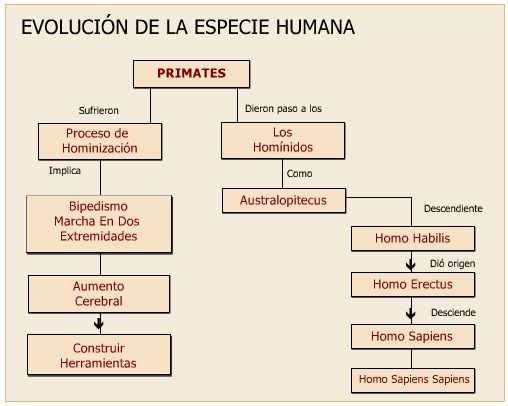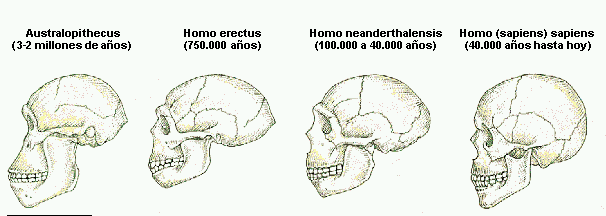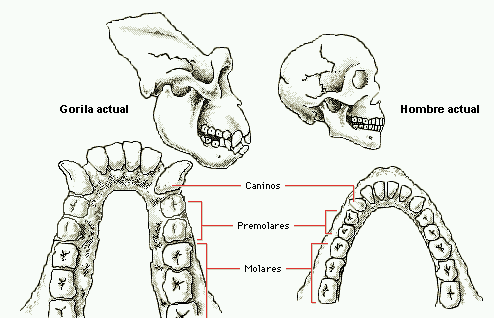In recent years, the Social Sciences have made important progress but, as we move forward, we are convinced that the problems increase. Tracing the origins of man is the task that tirelessly occupies hundreds of researchers around the world. In different places there are indications that allow to formulate hypotheses and elaborate complex demonstrations.
It happens that whoever gets the answer to this question will also have discovered the origin of a characteristic that has thrown us into an intellectual evolution whose limits seem not to exist. The quality that moves men to the achievement of all their tasks has a name: Curiosity.

Comparative illustration of the skeletons of several primates among which are: gibbon, orangutan, chimpanzee, gorilla and Homo sapiens. This famous illustration was first published in Thomas Henry Huxley's book Evidence to Man's Place in Nature of 1863. Huxley is known as Darwin's Bulldog for his defense of Charles Darwin's theory of evolution.
Never as in our time has humanity provided more wealth of information about the world around him. Never before today, the audiovisual mediums have poured on young people a similar amount of images and news about events and men, environments and activities, present and past, remote worlds. And yet, curiosity has never been greater to understand more and more, to find all the answers.
THE STUDY OF THE MATERIAL REMAINS
To reconstruct the past of men who had not yet invented writing, it is only possible to rely on special research techniques. These techniques allow extracting information from the material remains left by those men, such as their bones, the instruments they made with stones, or the remains of food.
Archeology is the discipline that studies these material remains. But the archaeologist does not limit himself to collecting beautiful objects as if he were a collector. His work consists of reconstructing the life of the human groups that left behind material remains: they must deduce their antiquity, reconstruct the forms of subsistence, their customs and rites, their social organization.
The archaeological excavation:
After carrying out bibliographical and field research, the archaeologist arrives at the site where he assumes that he will find material remains of disappeared cultures. Centuries, millennia of human life rest under a few meters of land.
"All the unwritten history of humanity is enclosed in the superimposed sheets of the book of the earth, and the technique of the excavation has as its first objective to ensure its correct reading," said a contemporary archaeologist".
Emergence of mammals
65 million years ago disappeared the great reptiles dinosaurs and began the development of mammals. These little animals that left the ground to climb the trees. The jump to life on the trees was due, possibly, to the need to survive.
We can say that the disappearance of the great dinosaurs, the surviving mammals occupied the predominant place in nature and among them were the primates that lived in the treetops and developed a great capacity to survive: they had a superior brain since they could coordinate the sight and movement of the hands. His hands were prehensile and the position of the eyes allowed them a three-dimensional vision.
Basic Characteristics of Primates:
The name "Primates" was used for the first time by Linnaeus in 1758 in his taxonomic arrangement of the animals; means "first" in Latin. Linnaeus included in his order Primates humans, anthropomorphic monkeys, Old World monkeys and monkeys of the New World, distinguishing them from the rest of mammals, which he called "Secundates" (seconds).
The group of primates have anatomical characteristics that have certain features that together allow them to be identified.
As characteristics of primates can be mentioned:
- Hands and feet with five fingers
- Feet plantigrade.
- Ompible thumb in hands and feet (some species, like man, have lost the ability to oppose the thumb of the foot).
- Clavicles present.
- Flat nails instead of claws (in the vast majority of species).
- Color vision (in the vast majority of species).
- Well-developed shoulder and elbow joints.
- Well developed cerebral hemispheres.
- Binocular vision (in different degrees).
- Ocular orbits surrounded by bone.
The long period from the appearance of man to the invention of writing is called the stone age. In turn, the age of Stone is divided into two stages: the Paleolithic, which means carved or ancient stone and the Neolithic which means polished or new stone. These words call the binding on the type of work that the first men were doing with the stones, from barely worked stones, almost pebbles, first to stones carved later, until arriving at polished and beautifully adorned stones. This increasingly complex work and with more details allows us to suppose that the techniques used to create those tools or utensils were also more complex, and at the same time more complex were the needs that satisfied man.
Emergence of primates
70 million years ago, mammals developed different types of monkeys called primates. The first primates were small, nocturnal animals that lived (almost always) on trees.
Over time, some of them changed their habits and physical characteristics: their skull was bigger, their brain grew, they could take objects with their hands, adapt to the day and eat fruits and vegetables.
From the common trunk of primates, two branches of monkeys emerged:
- those of the apes: chimpanzee, gorilla and orangutan
- the hominids or protohumans, giving origin to the current man
-# Hominids or first humans:
This is the name given to one of the two families of monkeys in which the primate group was divided. While in the family of the orangutan, the gorilla and the chimpanzee there were no changes, 15 million years ago in the family of hominids began the evolution to modern man.
The first hominids and the long way to man: Diverse were the species that united the current man with the first hominids. The species that represented true evolutionary leaps, that is, true moments of change, were the following:
Australopithecus: ("southern monkeys") was the first bipedal hominid (it walked on two legs and could run on flat ground). He had powerful jaws and strong molars. Long members and spent much of their lives in the trees. His brain had a volume of less than 400 cubic centimeters. From this it follows that the upright walking occurred long before the expansion of the brain. Its size does not exceed 1.20 m. of height and 30 Kg. of weight. Antiquity: 3 or 4 million years.
It is represented by a group of prehuman fossils found in the south and east of Africa. The oldest fossils are approximately 5 million years old and the most recent, 1 million years old. The first australopithecus was found in the 1960s in East Africa, (Ethiopia) and was named Lucy.
Homo habilis: ("skillful man") This species of hominids, had to adopt a more upright position because climatic variations made the grasslands grow and forced them to stand on their feet to see possible dangers. They had a larger brain, around 750 cubic centimeters. Their most important characteristic was the change in their diet: they no longer ate only fruits and vegetables but also animals. Hairy body. Currently researchers do not agree on whether the homo habilis hunted intentionally and manufactured tools to do so. It is believed they could have spoken. Fossil remains were found in the Olduvai Gorge (Tanzania) along with the first utensils. Antiquity: 2 million years
Homo erectus: ("erect man") Also called Pithecanthropus Erectus. Some considered it the direct representative of man, but today it is known that many previous austratopithecus possessed similar traits. They are the first hominids that were widely distributed on the surface of the planet, reaching southeast and east of Asia. Tall body, thick eyebrows and big muscles. They had a brain greater than that of homo habilis: around 1,100 cubic centimeters. They discovered the use of fire and made the first hand ax. The first homo erectus was found in Java (Oceania) at the end of the last century. The discovery of remains of hominids of this species in the caves of Beijing allowed the reconstruction of some aspects of his life. Antiquity: 1.5 million years.
Of all the existing theories about the origins of modern man, the one that seems to have the most credit is the one advocated by the so-called "replacement model", that is, the appearance of Homo sapiens sapiens in the African continent and its subsequent expansion by the rest of the planet.
The fossilized remains of different individuals found in 1997 near the village of Herto, in Ethiopia, testify that, about 160,000 years ago, there were already human beings in Africa very similar to us. According to the data that the scientists handle, the Homo sapiens sapiens, the subspecies to which we all belong, would have appeared between 200,000 and 160,000 years ago.
And he did it with certainty in the same regions where hominids had adopted bipedal walk more than 4 million years ago, and where, for the first time, a kind of human appearance learned to make tools, 2.5 million years ago years.
The bone structure of humans makes it possible to walk erect and with less energy expenditure than that of the apes that swing from side to side. The curvature of the human spine provides greater balance and a better distribution of body weight; the pelvis is wider, which favors the insertion of the muscles that participate in the upright gait; the hole at the base of the skull, through which the spinal cord passes, is centered and leaves the head in a proper position for upright walking; The big toe is aligned with the rest of the fingers, which increases the ability to walk or run straight forward.

SKULL EVOLUTION:

The human skull has changed drastically during the last 3 million years. The evolution from the Australopithecus to the Homo sapiens, meant the increase of the cranial capacity (to adjust to the growth of the brain), the flattening of the face, the recoil of the chin and the decrease in the size of the teeth. Scientists think that the incredible growth of brain size may be related to the greater sophistication of hominid behavior. Anthropologists, for their part, point out that the brain developed its high capacity for learning and reasoning, after cultural evolution, and not physical evolution, changed the way of life of human beings.
GORILLA SKULL IN FRONT OF HUMAN SKULL

Modern humans are primates, as well as gorillas, lemurs and chimpanzees. At some point in evolution, human development continued on a different path. Although there are many similarities between humans and primates (especially gorillas and chimpanzees), there are fundamental differences that attest to this independent evolution in their respective developments. This illustration of the skulls of a gorilla and a modern human being presents some of these differences. The gorilla has long canines and its jaw is more prominent than the members of the line of hominids.
Bibliography :
- https://en.wikipedia.org/wiki/Human_evolution
- https://answersingenesis.org/human-evolution/ape-man/the-origin-of-humans/
- https://www.allaboutscience.org/evolution-of-man.htm
- https://www.britannica.com/science/human-evolution
- http://www.scienceandapologetics.org/engl/g1.htm
- https://en.wikibooks.org/wiki/Ancient_History/Human_Evolution/Recent_African_Origin